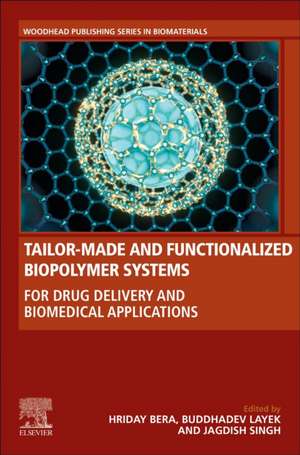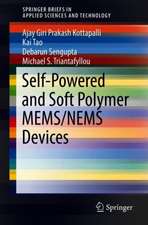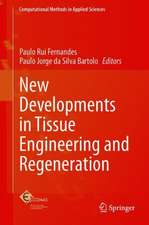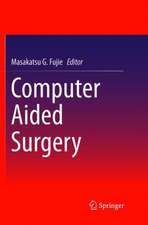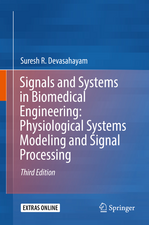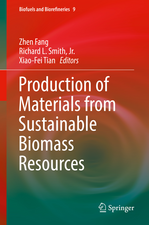Tailor-Made and Functionalized Biopolymer Systems: For Drug Delivery and Biomedical Applications: Woodhead Publishing Series in Biomaterials
Editat de Hriday Bera, Buddhadev Layek, Jagdish Singhen Limba Engleză Paperback – 28 iul 2021
- Provides a concise overview of tailor-made and functionalized biopolymer systems for biomedical applications
- Covers a range of modified biopolymers, biopolymeric composites and biopolymer-based systems in drug delivery, development of artificial organs, diagnostic applications, and more
- Describes characterization, synthesis and functionalization of biopolymers and biopolymers systems
Din seria Woodhead Publishing Series in Biomaterials
- 5%
 Preț: 1209.61 lei
Preț: 1209.61 lei - 9%
 Preț: 1288.81 lei
Preț: 1288.81 lei - 20%
 Preț: 1116.12 lei
Preț: 1116.12 lei - 36%
 Preț: 1030.16 lei
Preț: 1030.16 lei - 5%
 Preț: 1403.92 lei
Preț: 1403.92 lei - 26%
 Preț: 990.05 lei
Preț: 990.05 lei - 5%
 Preț: 1047.40 lei
Preț: 1047.40 lei - 5%
 Preț: 1097.68 lei
Preț: 1097.68 lei - 36%
 Preț: 847.30 lei
Preț: 847.30 lei - 9%
 Preț: 1159.07 lei
Preț: 1159.07 lei - 5%
 Preț: 1341.04 lei
Preț: 1341.04 lei - 5%
 Preț: 1116.94 lei
Preț: 1116.94 lei - 5%
 Preț: 1115.67 lei
Preț: 1115.67 lei - 20%
 Preț: 901.66 lei
Preț: 901.66 lei - 5%
 Preț: 1114.31 lei
Preț: 1114.31 lei - 26%
 Preț: 903.89 lei
Preț: 903.89 lei - 36%
 Preț: 939.94 lei
Preț: 939.94 lei - 5%
 Preț: 1511.72 lei
Preț: 1511.72 lei - 5%
 Preț: 1071.15 lei
Preț: 1071.15 lei - 9%
 Preț: 1090.57 lei
Preț: 1090.57 lei - 9%
 Preț: 1044.12 lei
Preț: 1044.12 lei - 29%
 Preț: 847.49 lei
Preț: 847.49 lei - 9%
 Preț: 1003.98 lei
Preț: 1003.98 lei - 5%
 Preț: 1050.99 lei
Preț: 1050.99 lei - 5%
 Preț: 1600.80 lei
Preț: 1600.80 lei - 5%
 Preț: 986.00 lei
Preț: 986.00 lei - 5%
 Preț: 1118.83 lei
Preț: 1118.83 lei - 5%
 Preț: 1050.99 lei
Preț: 1050.99 lei - 20%
 Preț: 1038.08 lei
Preț: 1038.08 lei - 5%
 Preț: 902.90 lei
Preț: 902.90 lei - 9%
 Preț: 1070.42 lei
Preț: 1070.42 lei - 5%
 Preț: 1512.75 lei
Preț: 1512.75 lei - 29%
 Preț: 1282.87 lei
Preț: 1282.87 lei - 25%
 Preț: 1121.07 lei
Preț: 1121.07 lei - 5%
 Preț: 1253.32 lei
Preț: 1253.32 lei - 9%
 Preț: 1204.85 lei
Preț: 1204.85 lei - 26%
 Preț: 1046.86 lei
Preț: 1046.86 lei - 5%
 Preț: 835.44 lei
Preț: 835.44 lei - 5%
 Preț: 838.79 lei
Preț: 838.79 lei - 5%
 Preț: 940.93 lei
Preț: 940.93 lei - 20%
 Preț: 1290.67 lei
Preț: 1290.67 lei - 5%
 Preț: 940.63 lei
Preț: 940.63 lei - 5%
 Preț: 1115.22 lei
Preț: 1115.22 lei - 5%
 Preț: 989.25 lei
Preț: 989.25 lei - 20%
 Preț: 1598.75 lei
Preț: 1598.75 lei - 20%
 Preț: 964.40 lei
Preț: 964.40 lei - 20%
 Preț: 903.00 lei
Preț: 903.00 lei - 5%
 Preț: 1333.41 lei
Preț: 1333.41 lei
Preț: 2254.76 lei
Preț vechi: 2373.43 lei
-5% Nou
Puncte Express: 3382
Preț estimativ în valută:
431.50€ • 468.55$ • 362.46£
431.50€ • 468.55$ • 362.46£
Carte tipărită la comandă
Livrare economică 23 aprilie-07 mai
Preluare comenzi: 021 569.72.76
Specificații
ISBN-13: 9780128214374
ISBN-10: 0128214376
Pagini: 788
Ilustrații: 200 illustrations (60 in full color)
Dimensiuni: 152 x 229 mm
Greutate: 1.03 kg
Editura: ELSEVIER SCIENCE
Seria Woodhead Publishing Series in Biomaterials
ISBN-10: 0128214376
Pagini: 788
Ilustrații: 200 illustrations (60 in full color)
Dimensiuni: 152 x 229 mm
Greutate: 1.03 kg
Editura: ELSEVIER SCIENCE
Seria Woodhead Publishing Series in Biomaterials
Cuprins
List of contributors xv
1 Introduction to tailor-made biopolymers in drug delivery
applications
Yasir Faraz Abbasi, Parthasarathi Panda, Sanjay Arora, Buddhadev Layek
and Hriday Bera
1.1 Introduction
1.2 Biopolymers from plant and animal kingdom
1.2.1 Polysaccharides
1.2.2 Polypeptides
1.2.3 Polynucleotides
1.3 Chemical modifications of biopolymers
1.3.1 Modification approaches of polysaccharides
1.3.2 Modification approaches of polypeptides
1.4 Tailor-made biopolymers as pharmaceutical excipients
1.5 Conclusion
References
Section 1 Modified biopolymers
2 Thiolated biopolymers in drug delivery and biomedical applications
Custodiana A. Colmenarez Lobo, Mirta L. Fascio and Norma B. D’Accorso
2.1 Introduction
2.2 Thiolated biopolymers in drug delivery applications
2.3 Thiolated biopolymers in biomedical applications
2.3.1 Medicinal applications
2.3.2 Diagnosis
2.3.3 Regenerative medicine
2.4 Conclusion and future perspectives
Acknowledgments
References
3 Smart biopolymers for controlled drug delivery applications
Sanjay Arora, Riddhi Trivedi, Richard N.L. Lamptey, Bivek Chaulagain,
Buddhadev Layek and Jagdish Singh
3.1 Introduction
3.2 Different types of smart biopolymers
3.2.1 Thermosensitive smart polymers
3.2.2 pH-sensitive smart polymers
3.2.3 Light-sensitive smart polymers
3.2.4 Phase-sensitive smart polymers
3.2.5 Bioresponsive smart polymers
3.3 Conclusion
References
4 Alginate-based systems for protein and peptide delivery
Paramita Paul, Gouranga Nandi, Mohammed A. Abosheasha and
Hriday Bera
4.1 Introduction
4.2 Alginate: sources, physicochemical and biological properties
4.2.1 Sources of alginates
4.2.2 Physicochemical properties
4.2.3 Biological properties
4.3 Modifications of alginate for protein and peptide delivery
4.3.1 Covalent chemical modifications
4.3.2 Polyelectrolyte complexes
4.4 Alginate-based systems for protein and peptide delivery
4.4.1 Model protein delivery
4.4.2 Insulin delivery
4.4.3 Angiogenic factor delivery
4.4.4 Chemokine delivery
4.4.5 Bone morphogenetic protein delivery
4.5 Conclusion
References
5 Chitosan-based polyelectrolyte complexes in biomedical
applications
Buddhadev Layek, Surajit Das and Shubhajit Paul
5.1 Introduction
5.2 Polyelectrolyte complexes
5.2.1 Mechanism of polyelectrolyte complexes formation
5.2.2 Preparation of PECs and factors influencing the formation
and stability of PECs
5.3 Applications of chitosan-based polyelectrolyte complexes
5.3.1 Drug delivery
5.3.2 Gene delivery
5.3.3 Tissue engineering
5.4 Conclusion
References
6 Tailor-made cyclodextrin-based nanomaterials as drug carriers
Kazi Ali, Pradyot Roy, Arindam Maity and Pranabesh Chakraborty
6.1 Introduction
6.1.1 History
6.1.2 Source of cyclodextrins
6.1.3 Types and structure of cyclodextrins
6.1.4 Properties of cyclodextrins
6.1.5 Inclusion complex formation
6.2 Modification of cyclodextrins
6.2.1 Principle and chemistry of cyclodextrin modification
6.2.2 Characterization of modified cyclodextrins
6.3 Cyclodextrin-based nanomaterials
6.3.1 Preparation of nanomaterials from cyclodextrins and
applications
6.3.2 Different cyclodextrin-based nanomaterials
6.4 Pharmaceutical and biomedical applications of tailor-made
CD-based nanomaterials
6.5 Conclusion and future prospects
References
Further reading
Section 2 Biopolymeric conjugates/composites
7 Biopolymer_metal oxide composites in biomedical
applications
Yasir Faraz Abbasi and Hriday Bera
7.1 Introduction
7.2 Applications of biopolymer_metal oxide composites
7.2.1 Drug delivery
7.2.2 Anticancer, antioxidant, and antimicrobial activities
7.2.3 Wound healing and tissue engineering
7.2.4 Biosensors, bioimaging, and diagnostics
7.3 Conclusion
References
8 Biopolymer_drug conjugates as biomaterials
Haifei Guo, Yasir Faraz Abbasi, Hriday Bera and Mingshi Yang
8.1 Introduction
8.2 Biopolymer_drug conjugates
8.2.1 Polysaccharide-drug conjugates
8.2.2 Polypeptide_drug conjugates
8.3 Conclusion
References
9 Functionalized biopolymer_clay-based composites as drug-cargos
Hriday Bera, Motoki Ueda and Yoshihiro Ito
9.1 Introduction
9.2 Structure and properties of clays
9.3 Biopolymer_clay intercalations
9.4 Properties of biopolymer_clay-based composites as drug-delivery
systems
9.4.1 Improvement of clay properties
9.4.2 Improvement of polymer properties
9.5 Biopolymer_clay-based composites as drug-delivery systems
9.5.1 Animal-derived polysaccharide_clay composites
9.5.2 Algae-derived polysaccharide_clay composites
9.5.3 Plant-derived polysaccharide_clay composites
9.5.4 Natural protein_clay composites
9.5.5 Biopolymer blend_clay composites
9.6 Conclusion
References
10 Mesoporous silica-biopolymer-based systems in drug delivery
applications
Suman Saha, Payal Roy and Jui Chakraborty
10.1 Introduction
10.2 Classification of MSNs, their structures and properties
10.2.1 Two-dimensional mesostructures
10.2.2 Three-dimensional mesostructures
10.2.3 Classification of mesoporous silica nanoparticles as
drug carriers
10.3 Different synthesis techniques of mesoporous silica nanoparticles
10.3.1 Hydrothermal synthesis
10.3.2 Aerosol-assisted synthesis
10.3.3 Modified St&e_004E7;ber’s synthesis
10.3.4 Template-assisted synthesis
10.3.5 Microwave synthesis
10.3.6 Chemical etching synthesis
10.4 Functionalization of mesoporous silica nanoparticles using
synthetic polymers/biopolymers
10.4.1 Functionalization techniques
10.5 Different biopolymer-MSN systems in drug delivery applications
10.5.1 Drug delivery for cancer treatment
10.5.2 Drug delivery for other disease treatment
10.5.3 Gene delivery
10.5.4 Drug delivery and bioimaging
10.6 Stability and degradation profiles
10.7 Biocompatibility, pharmacology, and toxicological profiles
10.8 Conclusion, challenges, and future prospects
Acknowledgments
References
Section 3 Modified biopolymer based biomaterials
11 Micellar drug-delivery systems based on amphiphilic block and graft
polysaccharides
Leonard Ionut Atanase
11.1 Introduction
11.2 Micellization and drug-loading methods
11.3 Characterization techniques of drug-free and drug-loaded
micellar systems
11.4 Polysaccharide-based micellar drug-delivery systems
11.4.1 Chitosan-based micellar drug-delivery systems
11.4.2 Cellulose-based micellar drug-delivery systems
11.4.3 Dextran-based micellar drug-delivery systems
11.4.4 Starch-based micellar drug-delivery systems
11.4.5 Alginate-based micellar drug-delivery systems
11.4.6 Hyaluronic acid_based micellar drug-delivery systems
11.4.7 Miscellaneous polysaccharide-based micellar
drug-delivery systems
11.5 Conclusions and perspectives
References
12 Engineering of biopolymer-based nanofibers for medical uses
Yang Chen, Hriday Bera, Dongmei Cun and Mingshi Yang
12.1 Introduction
12.2 Tissue engineering
12.3 Drug delivery
12.3.1 Drug delivery to the skin
12.3.2 Mucosal drug delivery
12.3.3 Controlled and sustained drug delivery
12.4 Stem cells
12.5 Sensors
12.6 Conclusion and future perspectives
References
Further reading
13 Engineered protein and protein-polysaccharide cages for drug
delivery and therapeutic applications
Isha Ghosh, Ujjwal Sahoo and Souvik Basak
13.1 Introduction
13.2 Proteins
13.3 Protein cages: engineering and therapeutic applications
13.3.1 Natural protein cages/scaffolds
13.3.2 Engineered protein cages
13.3.3 Therapeutic applications of protein cages
13.4 Protein-polysaccharide cages: engineering and therapeutic
applications
13.4.1 Electrostatic precipitation complexes/cages
13.4.2 Chemical reaction_mediated complexes/cages
13.4.3 Electrospun nanohybrid_mediated complexes/cages
13.4.4 Posttranslational modification_aided protein-polysaccharide
block copolymer complexes/cages
13.5 Conclusion and future perspectives
References
14 Biopolymeric hydrogels prepared via click chemistry as carriers of
therapeutic modalities
Rohit Bisht, Pinto Raveena, Sonali Nirmal, Shovanlal Gayen,
Gaurav K. Jain and Jayabalan Nirmal
14.1 Introduction
14.2 Properties of biopolymeric hydrogels
14.2.1 Swelling and solubility
14.2.2 Porosity and permeation
14.2.3 Drug release
14.3 Chemically cross-linked hydrogels
14.3.1 Cross-linking by free-radical polymerization
14.3.2 Cross-linking by click chemistry
14.4 Applications of biopolymeric click hydrogels in drug delivery
14.5 Conclusion and future prospects
Acknowledgement
References
15 Biopolymeric nanocrystals in drug delivery and biomedical
applications
Daphisha Marbaniang, Rajat Subhra Dutta, Niva Rani Gogoi,
Subhabrata Ray and Bhaskar Mazumder
15.1 Introduction
15.2 Generalized synthesis methods for biopolymeric nanocrystals
15.2.1 Mineral acid hydrolysis
15.2.2 Enzymatic hydrolysis
15.2.3 Co-precipitation method
15.3 Biopolymeric nanocrystals and their drug delivery and
biomedical applications
15.3.1 Biopolymeric nanocrystals
15.3.2 Reinforcement of biopolymeric nanocrystals with
biopolymers and vice versa
15.3.3 Biopolymers-assisted drug nanocrystals
15.4 Conclusion and future prospects
References
Section 4 Biopolymeric systems in biomedical
applications
16 Functionalized biopolymers for colon-targeted drug delivery
Yasir Faraz Abbasi and Syed Muhammad Farid Hasan
16.1 Introduction
16.2 Biopolymeric systems as colon-targeted drug carriers
16.2.1 Plant-derived polysaccharides
16.2.2 Animal-derived polysaccharides
16.2.3 Algae- and microbial-derived polysaccharides
16.2.4 Plant- and animal-derived polypeptides
16.3 Conclusion
References
17 Modified biopolymer-based systems for drug delivery to the brain
Abhimanyu Thakur, Rakesh Kumar Sidu, Isha Gaurav, Kumari Sweta,
Prosenjit Chakraborty and Sudha Thakur
17.1 Introduction
17.2 BBB and other common hurdles in brain drug delivery
17.3 Brain drug delivery by invasive methods
17.4 Brain drug delivery by the noninvasive methods
17.4.1 Chemical modification
17.4.2 Intranasal route
17.4.3 Aptamer
17.4.4 Extracellular vesicles
17.4.5 Ultrasound
17.4.6 Photodynamic effect
17.4.7 Extracorporeal shockwave
17.4.8 Laser-activated perfluorocarbon nanodroplets
17.4.9 Nanoformulations
17.5 Biopolymer-based systems for targeted drug delivery to the brain
17.5.1 Plant-derived polysaccharides
17.5.2 Animal-derived polysaccharides
17.5.3 Algae-derived and microbial polysaccharides
17.5.4 Polypeptides
17.6 Conclusion and future perspectives
Contributions
References
Further reading
18 Modified biopolymer-based chronotherapeutic drug-delivery systems
Somasree Ray and Shalmoli Seth Professor
18.1 Introduction
18.1.1 Clinical relevance of chronotherapeutic drug-delivery
systems
18.2 Concepts and terminologies used in chronotherapeutics
18.2.1 Period, level, amplitude, and phase
18.3 Common disease states under chronotherapy
18.3.1 Cardiovascular disease
18.3.2 Asthma
18.3.3 Pain
18.3.4 Diabetes
18.3.5 Gastric ulcer
18.3.6 Cancer
18.4 Drug-delivery strategies as chronopharmaceuticals
18.4.1 Chronotherapeutics
18.4.2 Ideal characteristics of chronotherapeutic drug-delivery
systems
18.4.3 Different techniques used to develop
chronopharmaceuticals
18.5 Biopolymer-based drug-delivery strategies as
chronopharmaceuticals
18.5.1 Hydrogels
18.5.2 Reservoir system based on swellable/erodible natural
polymers
18.5.3 Low-density floating microparticulate system based on
biopolymer
18.5.4 Modified natural polymers as chronopharmaceuticals
18.5.5 Pulsatile release from capsular system based on
biopolymeric plug
18.6 Conclusion
References
19 Biopolymeric systems for the delivery of nucleic acids
Rinku Dutta, Shyam S. Mohapatra and Subhra Mohapatra
19.1 Introduction
19.2 Types of nucleic acids used in gene therapy
19.3 Biopolymers used in gene delivery
19.3.1 Polysaccharides
19.3.2 Protein-based
19.4 Conclusion
References
20 Stimuli-responsive biopolymeric systems for drug delivery to
cancer cells
Viviane Seba, Gabriel Silva, Bor Shin Chee, Jeferson Gustavo Henn,
Gabriel Goetten de Lima, Zhi Cao, Mozart Marins and Michael Nugent
20.1 Introduction
20.2 Stimuli-responsive biopolymeric systems
20.2.1 Ultrasound responsive
20.2.2 Temperature responsive
20.2.3 pH responsive
20.2.4 Light responsive
20.2.5 Enzymatic responsive
20.2.6 Magnetic responsive
20.2.7 Redox responsive
20.2.8 Hypoxia responsive
20.3 Conclusion
References
21 Biopolymeric systems for diagnostic applications
Jacob Shreffler, Madison Koppelman, Babak Mamnoon, Sanku Mallik
and Buddhadev Layek
21.1 Introduction
21.2 Biopolymers used for various diseases
21.2.1 Infection
21.2.2 Cancer
21.2.3 Diabetes
21.2.4 Autoimmune hemolytic anemia
21.2.5 Blood sample stabilization
21.3 Conclusion
References
22 Functionalized biopolymer-based drug delivery systems:
current status and future perspectives
Buddhadev Layek
22.1 Introduction
22.2 Summary of topics
22.2.1 Introduction to tailor-made biopolymers in drug delivery
applications
22.2.2 Modified biopolymers
22.2.3 Biopolymeric conjugates/composites
22.2.4 Modified biopolymer-based biomaterials
22.2.5 Biopolymeric systems in biomedical applications
22.3 Conclusions and future perspectives
References
Index
1 Introduction to tailor-made biopolymers in drug delivery
applications
Yasir Faraz Abbasi, Parthasarathi Panda, Sanjay Arora, Buddhadev Layek
and Hriday Bera
1.1 Introduction
1.2 Biopolymers from plant and animal kingdom
1.2.1 Polysaccharides
1.2.2 Polypeptides
1.2.3 Polynucleotides
1.3 Chemical modifications of biopolymers
1.3.1 Modification approaches of polysaccharides
1.3.2 Modification approaches of polypeptides
1.4 Tailor-made biopolymers as pharmaceutical excipients
1.5 Conclusion
References
Section 1 Modified biopolymers
2 Thiolated biopolymers in drug delivery and biomedical applications
Custodiana A. Colmenarez Lobo, Mirta L. Fascio and Norma B. D’Accorso
2.1 Introduction
2.2 Thiolated biopolymers in drug delivery applications
2.3 Thiolated biopolymers in biomedical applications
2.3.1 Medicinal applications
2.3.2 Diagnosis
2.3.3 Regenerative medicine
2.4 Conclusion and future perspectives
Acknowledgments
References
3 Smart biopolymers for controlled drug delivery applications
Sanjay Arora, Riddhi Trivedi, Richard N.L. Lamptey, Bivek Chaulagain,
Buddhadev Layek and Jagdish Singh
3.1 Introduction
3.2 Different types of smart biopolymers
3.2.1 Thermosensitive smart polymers
3.2.2 pH-sensitive smart polymers
3.2.3 Light-sensitive smart polymers
3.2.4 Phase-sensitive smart polymers
3.2.5 Bioresponsive smart polymers
3.3 Conclusion
References
4 Alginate-based systems for protein and peptide delivery
Paramita Paul, Gouranga Nandi, Mohammed A. Abosheasha and
Hriday Bera
4.1 Introduction
4.2 Alginate: sources, physicochemical and biological properties
4.2.1 Sources of alginates
4.2.2 Physicochemical properties
4.2.3 Biological properties
4.3 Modifications of alginate for protein and peptide delivery
4.3.1 Covalent chemical modifications
4.3.2 Polyelectrolyte complexes
4.4 Alginate-based systems for protein and peptide delivery
4.4.1 Model protein delivery
4.4.2 Insulin delivery
4.4.3 Angiogenic factor delivery
4.4.4 Chemokine delivery
4.4.5 Bone morphogenetic protein delivery
4.5 Conclusion
References
5 Chitosan-based polyelectrolyte complexes in biomedical
applications
Buddhadev Layek, Surajit Das and Shubhajit Paul
5.1 Introduction
5.2 Polyelectrolyte complexes
5.2.1 Mechanism of polyelectrolyte complexes formation
5.2.2 Preparation of PECs and factors influencing the formation
and stability of PECs
5.3 Applications of chitosan-based polyelectrolyte complexes
5.3.1 Drug delivery
5.3.2 Gene delivery
5.3.3 Tissue engineering
5.4 Conclusion
References
6 Tailor-made cyclodextrin-based nanomaterials as drug carriers
Kazi Ali, Pradyot Roy, Arindam Maity and Pranabesh Chakraborty
6.1 Introduction
6.1.1 History
6.1.2 Source of cyclodextrins
6.1.3 Types and structure of cyclodextrins
6.1.4 Properties of cyclodextrins
6.1.5 Inclusion complex formation
6.2 Modification of cyclodextrins
6.2.1 Principle and chemistry of cyclodextrin modification
6.2.2 Characterization of modified cyclodextrins
6.3 Cyclodextrin-based nanomaterials
6.3.1 Preparation of nanomaterials from cyclodextrins and
applications
6.3.2 Different cyclodextrin-based nanomaterials
6.4 Pharmaceutical and biomedical applications of tailor-made
CD-based nanomaterials
6.5 Conclusion and future prospects
References
Further reading
Section 2 Biopolymeric conjugates/composites
7 Biopolymer_metal oxide composites in biomedical
applications
Yasir Faraz Abbasi and Hriday Bera
7.1 Introduction
7.2 Applications of biopolymer_metal oxide composites
7.2.1 Drug delivery
7.2.2 Anticancer, antioxidant, and antimicrobial activities
7.2.3 Wound healing and tissue engineering
7.2.4 Biosensors, bioimaging, and diagnostics
7.3 Conclusion
References
8 Biopolymer_drug conjugates as biomaterials
Haifei Guo, Yasir Faraz Abbasi, Hriday Bera and Mingshi Yang
8.1 Introduction
8.2 Biopolymer_drug conjugates
8.2.1 Polysaccharide-drug conjugates
8.2.2 Polypeptide_drug conjugates
8.3 Conclusion
References
9 Functionalized biopolymer_clay-based composites as drug-cargos
Hriday Bera, Motoki Ueda and Yoshihiro Ito
9.1 Introduction
9.2 Structure and properties of clays
9.3 Biopolymer_clay intercalations
9.4 Properties of biopolymer_clay-based composites as drug-delivery
systems
9.4.1 Improvement of clay properties
9.4.2 Improvement of polymer properties
9.5 Biopolymer_clay-based composites as drug-delivery systems
9.5.1 Animal-derived polysaccharide_clay composites
9.5.2 Algae-derived polysaccharide_clay composites
9.5.3 Plant-derived polysaccharide_clay composites
9.5.4 Natural protein_clay composites
9.5.5 Biopolymer blend_clay composites
9.6 Conclusion
References
10 Mesoporous silica-biopolymer-based systems in drug delivery
applications
Suman Saha, Payal Roy and Jui Chakraborty
10.1 Introduction
10.2 Classification of MSNs, their structures and properties
10.2.1 Two-dimensional mesostructures
10.2.2 Three-dimensional mesostructures
10.2.3 Classification of mesoporous silica nanoparticles as
drug carriers
10.3 Different synthesis techniques of mesoporous silica nanoparticles
10.3.1 Hydrothermal synthesis
10.3.2 Aerosol-assisted synthesis
10.3.3 Modified St&e_004E7;ber’s synthesis
10.3.4 Template-assisted synthesis
10.3.5 Microwave synthesis
10.3.6 Chemical etching synthesis
10.4 Functionalization of mesoporous silica nanoparticles using
synthetic polymers/biopolymers
10.4.1 Functionalization techniques
10.5 Different biopolymer-MSN systems in drug delivery applications
10.5.1 Drug delivery for cancer treatment
10.5.2 Drug delivery for other disease treatment
10.5.3 Gene delivery
10.5.4 Drug delivery and bioimaging
10.6 Stability and degradation profiles
10.7 Biocompatibility, pharmacology, and toxicological profiles
10.8 Conclusion, challenges, and future prospects
Acknowledgments
References
Section 3 Modified biopolymer based biomaterials
11 Micellar drug-delivery systems based on amphiphilic block and graft
polysaccharides
Leonard Ionut Atanase
11.1 Introduction
11.2 Micellization and drug-loading methods
11.3 Characterization techniques of drug-free and drug-loaded
micellar systems
11.4 Polysaccharide-based micellar drug-delivery systems
11.4.1 Chitosan-based micellar drug-delivery systems
11.4.2 Cellulose-based micellar drug-delivery systems
11.4.3 Dextran-based micellar drug-delivery systems
11.4.4 Starch-based micellar drug-delivery systems
11.4.5 Alginate-based micellar drug-delivery systems
11.4.6 Hyaluronic acid_based micellar drug-delivery systems
11.4.7 Miscellaneous polysaccharide-based micellar
drug-delivery systems
11.5 Conclusions and perspectives
References
12 Engineering of biopolymer-based nanofibers for medical uses
Yang Chen, Hriday Bera, Dongmei Cun and Mingshi Yang
12.1 Introduction
12.2 Tissue engineering
12.3 Drug delivery
12.3.1 Drug delivery to the skin
12.3.2 Mucosal drug delivery
12.3.3 Controlled and sustained drug delivery
12.4 Stem cells
12.5 Sensors
12.6 Conclusion and future perspectives
References
Further reading
13 Engineered protein and protein-polysaccharide cages for drug
delivery and therapeutic applications
Isha Ghosh, Ujjwal Sahoo and Souvik Basak
13.1 Introduction
13.2 Proteins
13.3 Protein cages: engineering and therapeutic applications
13.3.1 Natural protein cages/scaffolds
13.3.2 Engineered protein cages
13.3.3 Therapeutic applications of protein cages
13.4 Protein-polysaccharide cages: engineering and therapeutic
applications
13.4.1 Electrostatic precipitation complexes/cages
13.4.2 Chemical reaction_mediated complexes/cages
13.4.3 Electrospun nanohybrid_mediated complexes/cages
13.4.4 Posttranslational modification_aided protein-polysaccharide
block copolymer complexes/cages
13.5 Conclusion and future perspectives
References
14 Biopolymeric hydrogels prepared via click chemistry as carriers of
therapeutic modalities
Rohit Bisht, Pinto Raveena, Sonali Nirmal, Shovanlal Gayen,
Gaurav K. Jain and Jayabalan Nirmal
14.1 Introduction
14.2 Properties of biopolymeric hydrogels
14.2.1 Swelling and solubility
14.2.2 Porosity and permeation
14.2.3 Drug release
14.3 Chemically cross-linked hydrogels
14.3.1 Cross-linking by free-radical polymerization
14.3.2 Cross-linking by click chemistry
14.4 Applications of biopolymeric click hydrogels in drug delivery
14.5 Conclusion and future prospects
Acknowledgement
References
15 Biopolymeric nanocrystals in drug delivery and biomedical
applications
Daphisha Marbaniang, Rajat Subhra Dutta, Niva Rani Gogoi,
Subhabrata Ray and Bhaskar Mazumder
15.1 Introduction
15.2 Generalized synthesis methods for biopolymeric nanocrystals
15.2.1 Mineral acid hydrolysis
15.2.2 Enzymatic hydrolysis
15.2.3 Co-precipitation method
15.3 Biopolymeric nanocrystals and their drug delivery and
biomedical applications
15.3.1 Biopolymeric nanocrystals
15.3.2 Reinforcement of biopolymeric nanocrystals with
biopolymers and vice versa
15.3.3 Biopolymers-assisted drug nanocrystals
15.4 Conclusion and future prospects
References
Section 4 Biopolymeric systems in biomedical
applications
16 Functionalized biopolymers for colon-targeted drug delivery
Yasir Faraz Abbasi and Syed Muhammad Farid Hasan
16.1 Introduction
16.2 Biopolymeric systems as colon-targeted drug carriers
16.2.1 Plant-derived polysaccharides
16.2.2 Animal-derived polysaccharides
16.2.3 Algae- and microbial-derived polysaccharides
16.2.4 Plant- and animal-derived polypeptides
16.3 Conclusion
References
17 Modified biopolymer-based systems for drug delivery to the brain
Abhimanyu Thakur, Rakesh Kumar Sidu, Isha Gaurav, Kumari Sweta,
Prosenjit Chakraborty and Sudha Thakur
17.1 Introduction
17.2 BBB and other common hurdles in brain drug delivery
17.3 Brain drug delivery by invasive methods
17.4 Brain drug delivery by the noninvasive methods
17.4.1 Chemical modification
17.4.2 Intranasal route
17.4.3 Aptamer
17.4.4 Extracellular vesicles
17.4.5 Ultrasound
17.4.6 Photodynamic effect
17.4.7 Extracorporeal shockwave
17.4.8 Laser-activated perfluorocarbon nanodroplets
17.4.9 Nanoformulations
17.5 Biopolymer-based systems for targeted drug delivery to the brain
17.5.1 Plant-derived polysaccharides
17.5.2 Animal-derived polysaccharides
17.5.3 Algae-derived and microbial polysaccharides
17.5.4 Polypeptides
17.6 Conclusion and future perspectives
Contributions
References
Further reading
18 Modified biopolymer-based chronotherapeutic drug-delivery systems
Somasree Ray and Shalmoli Seth Professor
18.1 Introduction
18.1.1 Clinical relevance of chronotherapeutic drug-delivery
systems
18.2 Concepts and terminologies used in chronotherapeutics
18.2.1 Period, level, amplitude, and phase
18.3 Common disease states under chronotherapy
18.3.1 Cardiovascular disease
18.3.2 Asthma
18.3.3 Pain
18.3.4 Diabetes
18.3.5 Gastric ulcer
18.3.6 Cancer
18.4 Drug-delivery strategies as chronopharmaceuticals
18.4.1 Chronotherapeutics
18.4.2 Ideal characteristics of chronotherapeutic drug-delivery
systems
18.4.3 Different techniques used to develop
chronopharmaceuticals
18.5 Biopolymer-based drug-delivery strategies as
chronopharmaceuticals
18.5.1 Hydrogels
18.5.2 Reservoir system based on swellable/erodible natural
polymers
18.5.3 Low-density floating microparticulate system based on
biopolymer
18.5.4 Modified natural polymers as chronopharmaceuticals
18.5.5 Pulsatile release from capsular system based on
biopolymeric plug
18.6 Conclusion
References
19 Biopolymeric systems for the delivery of nucleic acids
Rinku Dutta, Shyam S. Mohapatra and Subhra Mohapatra
19.1 Introduction
19.2 Types of nucleic acids used in gene therapy
19.3 Biopolymers used in gene delivery
19.3.1 Polysaccharides
19.3.2 Protein-based
19.4 Conclusion
References
20 Stimuli-responsive biopolymeric systems for drug delivery to
cancer cells
Viviane Seba, Gabriel Silva, Bor Shin Chee, Jeferson Gustavo Henn,
Gabriel Goetten de Lima, Zhi Cao, Mozart Marins and Michael Nugent
20.1 Introduction
20.2 Stimuli-responsive biopolymeric systems
20.2.1 Ultrasound responsive
20.2.2 Temperature responsive
20.2.3 pH responsive
20.2.4 Light responsive
20.2.5 Enzymatic responsive
20.2.6 Magnetic responsive
20.2.7 Redox responsive
20.2.8 Hypoxia responsive
20.3 Conclusion
References
21 Biopolymeric systems for diagnostic applications
Jacob Shreffler, Madison Koppelman, Babak Mamnoon, Sanku Mallik
and Buddhadev Layek
21.1 Introduction
21.2 Biopolymers used for various diseases
21.2.1 Infection
21.2.2 Cancer
21.2.3 Diabetes
21.2.4 Autoimmune hemolytic anemia
21.2.5 Blood sample stabilization
21.3 Conclusion
References
22 Functionalized biopolymer-based drug delivery systems:
current status and future perspectives
Buddhadev Layek
22.1 Introduction
22.2 Summary of topics
22.2.1 Introduction to tailor-made biopolymers in drug delivery
applications
22.2.2 Modified biopolymers
22.2.3 Biopolymeric conjugates/composites
22.2.4 Modified biopolymer-based biomaterials
22.2.5 Biopolymeric systems in biomedical applications
22.3 Conclusions and future perspectives
References
Index
